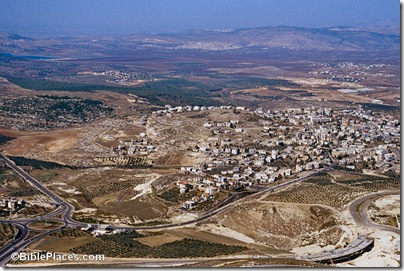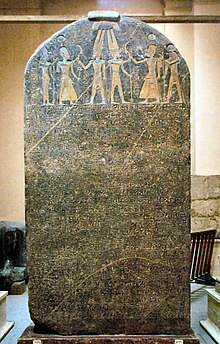 |
| the artist Guercino's depiction of Abraham, courtesy, Wikipedia |
Abraham, the first of the Hebrew patriarchs and son of Terah, an idol maker, was born “Abram” in the town of Ur of the Chaldees in Sumer, today, in the Arab-occupied country of “Iraq”. Today, the descendants of the Sumerians, the “Marsh Arabs”, still live in their ancient territory, much of which, now constitutes the marshes of southern Iraq. They are often persecuted by the surrounding Arab settlers, most notably in recent times, by Saddam Hussein. In Abram’s time however, they belonged to a powerful empire and were largely city-dwellers and farmers, worshipping their local gods. In this atmosphere, Abram, while still young, came to the conclusion that there was only one god. How he came to that conclusion is not recorded but in later centuries, rabbis have often speculated as written in later rabbinic writings. Later, Abram, his wife (and half-sister) Sarai, his father Terah, and his nephew Lot and his family, left Ur for Haran, today, in southern Turkey, where Terah died. While sojourning there, Abram was commanded by god to leave Haran and to settle in “the land that I will show you.” He obeyed and taking his family, set out on the long journey south eventually arriving in Canaan. Upon their arrival, they settled in the hamlet of Elon Moreh, just a few miles outside of Shechem (Nablus). This was the first place in Canaan where Abram and his household settled. It was there that “the lord appeared to him and said, ‘Unto your seed will I give this land’” (Gen. 12:7). Eventually, Abram and his family made their way to the southern part of Canaan, today, the Negev desert. While there, disputes erupted between his sheepherders and those of Lot, causing Lot’s household to separate from Abram’s and eventually, they settled in the town of Sodom. Later, Abram and his household settled in Mamre on the northern outskirts of Hebron. At this point, he was still childless and with Sarai’s urging, he took her handmaid Hagar as a concubine. Soon after, Hagar became pregnant and began to oppress Sarai because of that. Again, through Sarai’s urging, Abram cast Hagar out of his household. Wandering aimlessly in the desert, god told her to return to Sarai and submit. She did so and soon, her son Ishmael was born. (Some scholars say that Ishmael was the father of the Arabs, but the Arabs are a people that pre-date Abraham.) It was at this time that god appeared to Abram and changed his name to “Abraham” (Heb. “Avraham” – “father of multitudes”), “for the father of a multitude of nations have I made you…And I will establish my covenant between me and you, and your seed after you in their generations for an everlasting covenant.” Sarai’s name was also changed from “Sarai” to “Sarah”. As a sign of this everlasting contract, Abraham instituted circumcision of every eight-day-old male child. With great daring, he pleaded with god not to destroy the wicked people of Sodom and Gomorrah, even if there were only ten righteous men among them. Ten righteous men could not be found and so the towns were destroyed, but not before three angels of god saved Lot and his family. Finally, at the age of 90, Sarah bore a son and named him Isaac. Eventually, both Hagar and Ishmael were banished from Abraham’s household again for their misbehaviors. This time, both mother and son began to wander aimlessly in the desert when god appeared to Hagar again and told her that Ishmael would become the father of a great nation but Isaac would inherit the succession from Abraham. In the story of the sacrifice of Isaac, Abraham’s submission to the will of god was tested. As commanded, he placed Isaac on the altar preparing to offer him up. An angel of god restrained him, “Lay not thy hand upon the lad…for now I know thou fearest god.” Then Abraham lifted up his eyes and saw a ram “caught up in a thicket by his horns.” This ram he sacrificed instead of his son. Sarah died in Kiryat Arba near Hebron at the age of 127. After Abraham’s mourning period, he requested from Ephron the Hittite, the son of Zohar and leading chieftain of the area, a burial place for his wife, himself, and his son and grandson and their wives. Ephron happened to own a cave at the end of a field known as Machpelah and Abraham offered to buy it for "the full price". Ephron replied that the field was worth four hundred shekels of silver and Abraham agreed to it without any further bargaining. And this was where Sarah was buried. The next burial in the cave was that of Abraham himself, who died at the age of 175 and was buried by his sons Isaac and Ishmael. The title deed to the cave was part of the property of Abraham that passed to his son Isaac. It has serve as a place of Jewish pilgrimage ever since.
 |
| Herodian building over the Cave of Machpelah, courtesy, Wikipedia |
Between
31 and 4 BCE, Herod the Great built
a large, rectangular enclosure over the cave to commemorate the site for his subjects. It
is the only fully surviving Herodian structure from the period of Hellenistic Judaism. After the compilations of the Palestinian and
Babylonian Talmuds in the 4th and 6th centuries
respectively, Machpelah was often mentioned. The Piacenza Pilgrim (c. 570) noted in his pilgrimage account that Jews
and Christians shared possession of the site. After the Arab Muslim conquest in
the 7th century, the Muslims permitted the building of two small
synagogues at the site. When the Crusaders took control of it, Jews were banned
from using the synagogues but access to the caves was occasionally allowed. During
this period, the Damascene nobleman and historian Ibn al-Qalanisi in
his chronicle alluded to the discovery of relics purported to
be those of Abraham, Isaac and Jacob, a discovery that excited eager curiosity
among all three monotheistic communities in the southern Levant, especially
among the Jews. Towards the end of the period of Crusader rule, in 1165 Maimonides visited Hebron
and wrote, "On Sunday, 9 Marheshvan (17 October), I left Jerusalem for
Hebron to kiss the tombs of my ancestors in the Cave. On that day, I stood in
the cave and prayed, praise be to God, (in gratitude) for everything." In
1170, Benjamin of Tudela visited the Tombs of the Patriarchs which he referred
to as the St. Abram Church. Shmuel ben Shimshon visited the cave in 1210
and stated that the visitor must descend by twenty-four steps in a passageway
so narrow that the rock touches him on either hand. The successor to Crusader
rule, the Mamluks, established a mosque at the site and forbade Jews from
entering the cave at all, allowing them only as close as the fifth step on a staircase
at the southeast, but after some time this was increased to the seventh step.
After
Jordan occupied Judea and Samaria in 1948, no Jew was allowed in the territory
and consequently, Jews could visit the tomb. Following the Israeli liberation in the Six-Day War, Hebron returned
to Jewish control for the first time in 2,000 years and the 700-year-long
restriction limiting Jews to the seventh step was lifted. According to the autobiography
of the Chief Rabbi of the Israel Defense Forces, Major General Rabbi Shlomo Goren, on June 8, 1967, during the Six-day war, he (Goren) made
his way from Gush Etzion to Hebron where he realized that the Arabs had
surrendered and quickly made his way to the Cave of the Patriarchs. He entered
and began to pray, becoming the first Jew to enter the compound in 700 years.
While praying, a messenger from the Mufti of Hebron delivered a surrender note
to him, whereby the rabbi replied, "This place, Ma'arat HaMachpela, is a
place of prayer and peace. Surrender elsewhere." After the war, a small
synagogue was reestablished under the mosque and the first Jewish wedding
ceremony took place on the site on August 7, 1968. The first Jew to enter
the underground caves was Michal Arbel, the 13-year-old daughter of Yehuda
Arbel, chief of Shin Bet operations, on October 9, because she was slender
enough to be lowered into the narrow, 11 inch wide hole. At the same time
though, the Zionist authorities allowed Arab terrorism to be rife in the area.
In 1968, a special arrangement was made to accommodate Jewish services on Rosh
Hashanah and Yom Kippur. This led to a hand-grenade being thrown on the
stairway leading to the tomb. 47 Israelis were injured, 8 seriously. On
November 4, a large explosion went off near the gate to the compound and 6
people, Jews and Arabs, were wounded. On Yom Kippur eve,
October 3, 1976, an Arab mob destroyed several Torah scrolls and
prayer books at the tomb. In May 1980, an attack on Jewish worshippers
returning from prayers at the tomb left 6 dead and 17 wounded.
In a rare showing of Jewish vigilantism on Arabs, the Cave of the Patriarchs massacre, February, 1994, committed by Baruch Goldstein, left 29 Arab Muslims dead and scores injured. The resulting riots led to a further 35 deaths. As a result, the Wye River Accords, signed between the Zionists and the Arabs, included a temporary status agreement for the site restricting access for both Jews and Muslims. As a result, the waqf (Islamic charitable trust) today controls 81% of the site. This includes the whole of the southeastern section, which lies above the only known entrance to the caves and possibly over the entirety of the caves themselves. Jews are restricted to entering by the southwestern side, and limited to the southwestern corridor and the corridors that run between the cenotaphs, while Muslims may enter only by the northeastern side but are allowed free rein of the remainder of the enclosure. As a consequence, Jews are not permitted to visit the Cenotaphs of Isaac or Rebecca, which lie entirely within the southeastern section, except for 10 days a year that hold special significance in Judaism. One of these days is the Shabbat Chayei Sarah, when the Torah portion concerning the death of Sarah and the purchase of the cave by Abraham, is read. In addition, the Zionists do not allow the Jewish religious authorities the right to maintain the site and allow only the waqf to do so. Tourists are permitted to enter but security has increased since the Intifada. On February 21, 2010, the Zionists uncommonly announced that it would include the site in a national heritage site protection and rehabilitation plan. Of course, an expected anti-Semitic reaction from much of the world followed.





